Contact Mazarrón Tourist Office +34 968 59 44 26
or send an Email
Click HereContact Mazarrón Tourist Office +34 968 59 44 26
or send an Email
Click Here


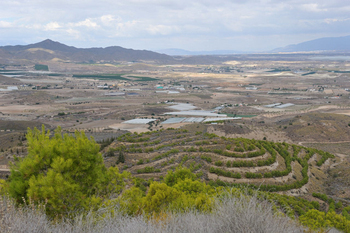 The village of Leiva lies to the west of the town of Mazarrón, and according to the Padrón register in 2021 was home to 307 inhabitants (including 48 non-Spanish Europeans). it is located at the edge of the plain of Mazarrón, in an area where there are various small ramblas (normally dry water courses) converging on the main one, the Rambla de las Moreras, which is recognized as a protected area.
The village of Leiva lies to the west of the town of Mazarrón, and according to the Padrón register in 2021 was home to 307 inhabitants (including 48 non-Spanish Europeans). it is located at the edge of the plain of Mazarrón, in an area where there are various small ramblas (normally dry water courses) converging on the main one, the Rambla de las Moreras, which is recognized as a protected area.
In the past the plain was used to grow barley and wheat, but nowadays the crops are rather different due to the installation of sophisticated drip-watering irrigation. Although the crops vary from year to year according to demand, tomatoes, peppers and melons are amongst the most popular.
The hamlet is fringed by the hills of the Coto de Fortuna, which is nowadays an attractive nature reserve, but in the late 19th and early 20th centuries was part of the mining boom in Mazarrón and yielded important quantities of alum and alumite. This is a surprisingly beautiful area, high above the flat plains, and the arid-looking peaks are in fact covered with young pine forests and are a welcoming oasis for walkers and lovers of the great outdoors. The lower slopes are dotted with the remains of Mazarron´s mining past.
History of Leiva
The Roman Mines
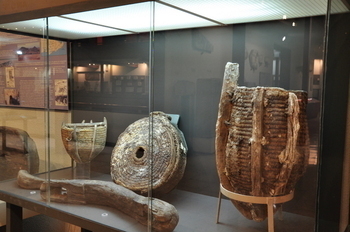
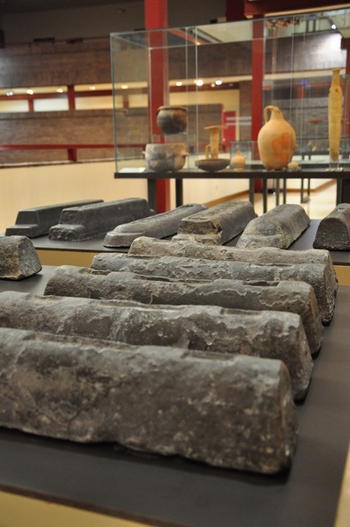
The resurgence of mining at the end of the 19th century in Mazarrón and other parts of Murcia - and indeed the rest of Spain - saw civil mining engineers beginning to take an interest in the archaeological evidence which their excavations often uncovered. In 1875, the engineer Alfred Leger produced the first study of the public administration of mines in Ancient Rome, and some of the archaeological findings were included in reports and diaries, a valuable record of many locations which were destroyed during the intensive mining in Mazarrón in the 19th and 20th centuries.
For the Romans, the area which is now the Region of Murcia provided rich natural resources including salt, esparto grass, fish which was used to make pungent sauces, lead, silver and alum. Mazarrón was particularly rich in minerals, and the mining was carefully managed and administered: regional governors appointed by Rome were in charge, before the management of mines was handed over to specialized administrators in around 180 BC.
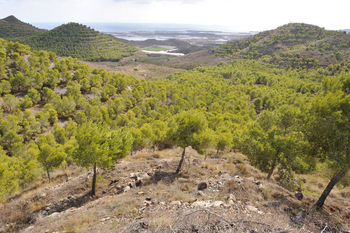 The archaeological museum of Cartagena contains ingots recovered from sunken ships bearing the names of the companies who mined and cast them, and similar ingots have been recovered in the Leiva area. In total more than a dozen areas have been analysed, and a wealth of material and structures has been found including column bases, inscription plates, ceramics, metal wedges (a typical tool used at the time), dividing walls from old rooms and even, according to a 19th century inventory, a metal ring containing the remains of a human tibia: this has been taken to indicate the use of slaves in this type of mine.
The archaeological museum of Cartagena contains ingots recovered from sunken ships bearing the names of the companies who mined and cast them, and similar ingots have been recovered in the Leiva area. In total more than a dozen areas have been analysed, and a wealth of material and structures has been found including column bases, inscription plates, ceramics, metal wedges (a typical tool used at the time), dividing walls from old rooms and even, according to a 19th century inventory, a metal ring containing the remains of a human tibia: this has been taken to indicate the use of slaves in this type of mine.
(In the nearby mines of the Sierra Minera over 35,000 slaves are documented as working in the Roman mines.)
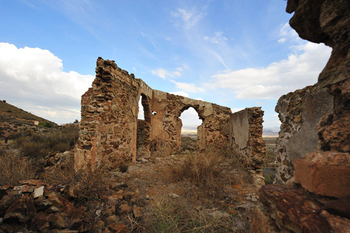 Archaeological digs have uncovered galleries, sink shafts, wall support systems, washing areas, tools, sandals and even hats made from esparto grass. The extraction systems seem to have been designed to take out not only the minerals found but also the water which was encountered when boring into the earth: among the devices used to dig ever deeper were stepped water wheels, Archimedes screws, and Ctesibius pumps. This technology enabled the Romans to dig far below the surface, despite the underground water deposits which are so abundant in the plains around Mazarrón.
Archaeological digs have uncovered galleries, sink shafts, wall support systems, washing areas, tools, sandals and even hats made from esparto grass. The extraction systems seem to have been designed to take out not only the minerals found but also the water which was encountered when boring into the earth: among the devices used to dig ever deeper were stepped water wheels, Archimedes screws, and Ctesibius pumps. This technology enabled the Romans to dig far below the surface, despite the underground water deposits which are so abundant in the plains around Mazarrón.
Following the departure of the Romans, though, the area was occupied by the Moors until the 13th century and they showed very little interest in the mines, limiting their activity mainly to agriculture. There are no noticeable remains of Moorish occupation in Leiva during this period.
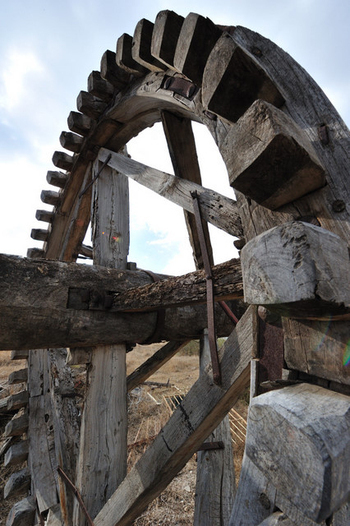 After the Reconquista of Murcia by Christian forces in 1243 the population of Mazarrón dropped sharply, and although the countryside must have been dotted with farmhouses and smallholdings from the end of the 13th century onwards, most of the remains found are from watchtowers and small fortresses.
After the Reconquista of Murcia by Christian forces in 1243 the population of Mazarrón dropped sharply, and although the countryside must have been dotted with farmhouses and smallholdings from the end of the 13th century onwards, most of the remains found are from watchtowers and small fortresses.
When Granada was taken by the Catholic Monarchs in 1492, ending the Moorish occupation of the south of Spain, there was a re-structuring of Spain, and the arrival of peace and the administrative reforms favoured the reactivation of the industry lost in Mazarrón. The mines in the foothills were re-opened in search of alum, which was now required for glass-making and pharmacology as well as for tanneries.
In the second half of the 15th century the mines were handed to the Fajardo and Pacheco families, who either managed them directly or employed others to do so. It is quite possible, given the ties between the lords of Leiva and Mazarrón (which is shown by the inscriptions on some of the houses in the town), that the village could have grown around a house or plot of land belonging to the Leiva family, but there is no documented evidence to support this theory and little to prove the relationship with the alum mines in Coto Fortuna at the time.
On 1st August 1572 Mazarrón was granted its independence and set up its own Town Hall, although it still suffered coastal raids by the Berber pirates from northern Africa throughout the 16th century. These raids and a crisis in the alum industry slowed economic development, and most of the efforts of the population were devoted to ensuring their safety and survival in the face of the pirate attacks: the countryside and other sources of economic production became neglected, and extremely depopulated.
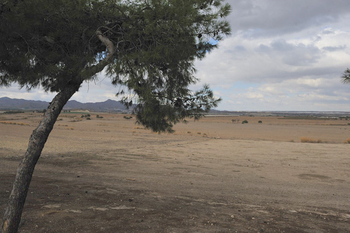
Like other nearby towns in Mazarrón, Leiva grew significantly in the second half of the 19th century in terms of both population and the economy. Mining activity prospered between 1840 and 1918, and this temporarily changed the face of the town. The First World War, in which Spain played no active part, was a great opportunity for the mining industry to increase its exports to the rest of Europe, where metals were needed to produce weapons.
By the end of the 19th century mining in Coto Fortuna was in the hands of the Sociedad Fortuna, based in Bilbao, which invested the handsome sum of five million pesetas in its operations here. Among the numerous mines opened the largest and best known was that of San Juan, which provided work for many of the locals. The population was swollen by immigrants seeking work, and some of the cave-houses in which they lived can still be seen today: these are very simple dwellings, typical of the temporary workers homes of the age.
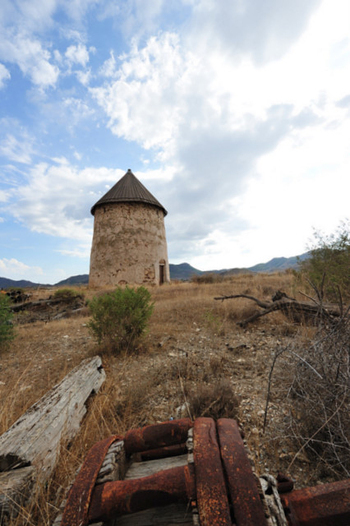 Apart from mining, though, there was also increased agricultural activity in the wheat and barley fields of Leiva. Evidence of this can still be seen in the windmills which are dotted along the roadsides, including the Molino de Leiva and the Molino del Rojo Fuentes. When mining activity declined fruit growing replaced it, although unfortunately the salinity of the water drawn from the local wells meant that it didnt prosper initially.
Apart from mining, though, there was also increased agricultural activity in the wheat and barley fields of Leiva. Evidence of this can still be seen in the windmills which are dotted along the roadsides, including the Molino de Leiva and the Molino del Rojo Fuentes. When mining activity declined fruit growing replaced it, although unfortunately the salinity of the water drawn from the local wells meant that it didnt prosper initially.
One by one the mines closed and the last in Mazarrón ceased to be active in 1967. From then on it became necessary to increase productivity on the land, and the arrival of water from the Tajo-Segura canal in the 1980s made it possible to develop and implement advanced drip-irrigation techniques. From that point on the traditional pomegranates and almonds have been supplemented by melons, water-melons and tomatoes.
Nowadays the centre of Leiva is very small, with most of the inhabitants living in country properties and agricultural smallholdings. There is a primary school and a social centre next to the church, where various activities are organized.
The church of Nuestra Señora del Carmen in Leiva
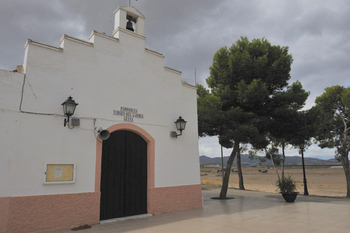 The Ermita de Leiva was built in Los Vidales after the old church, in the Finca de Las Qunitanas, was destroyed in a flood in 1883. When this one was built the increased population demanded that adjoining rooms be included to act as schoolrooms and meeting halls for the residents.
The Ermita de Leiva was built in Los Vidales after the old church, in the Finca de Las Qunitanas, was destroyed in a flood in 1883. When this one was built the increased population demanded that adjoining rooms be included to act as schoolrooms and meeting halls for the residents.
The current church was built over the remains of a building that was destroyed during the Civil War, and in 1941 the image of Leiva's patron saint, Nuestra Señora del Carmen, was placed in a niche to commemorate the end of its reconstruction. The first Mass in the church was held a year later.
The local fiestas in honour of the patron saint are held on 16th July.
Property in Leiva, Mazarrón
This is a small farming community with around 300 inhabitants and of course most of the properties are country farms: only a few modern buildings exist here.
Several expat families are scattered around the countryside in this part of Mazarrón, but facilities are limited. There are bars in the village and one very small store, but shopping and medical needs require driving into nearby Mazarrón (10 minutes by car). In some ways this is an ideal location for those wishing to be near to the facilities and beaches of Mazarrón but away from the hustle and bustle of built-up areas, and Leiva has not been totally smothered by greenhouses unlike some other rural areas within Mazarrón.
Location
For more local information, including what to see, what's on and news, visit the home page of Mazarrón Today.
